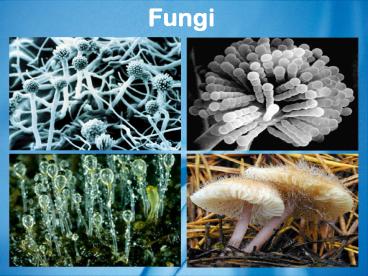Fungi - PowerPoint PPT Presentation
Title:
Fungi
Description:
Fungi When you think of fungus, what do you think of? Mold on your fruits? Mushrooms on your Pizza? * * Importance of Kingdom Fungi 1. many pathogenic species ex ... – PowerPoint PPT presentation
Number of Views:82
Avg rating:3.0/5.0
Title: Fungi
1
Fungi
2
When you think of fungus, what do you think of?
- Mold on your fruits?
- Mushrooms on your Pizza?
3
Importance of Kingdom Fungi
- 1. many pathogenic species
- ex. Ringworm
- ex. athletes foot
- ex. potato blight
- 2. decomposers
- i.e. saprophytes
- recycle dead organisms
- (fertilize soil)
- break down toxic waste
4
Importance of Kingdom Fungi
- 3. some species produce antibiotics
- ex. Penicillium
- 4. food source
- mushrooms (vitamin D)
- make blue cheeses
- 5. yeast used commercially to make
- bread
- beer wine
edible mushrooms
chicken of the woods
beefsteak
5
Similarities Between Plants Fungi
Plants Fungi
- eukaryotic cells
- numerous organelles
- multicellular (except yeast)
- have cell walls
- anchored in soil
- stationary
- reproduce asexually or sexually
6
Differences Between Plants Fungi
Plants Fungi
one nucleus per cell many nuclei per cell
autotrophs (make own food) Heterotrophs (must eat to get nutrition)
have roots no roots (filaments instead!)
cellulose in cell walls chitin in cell walls (like insects)
reproduce by seeds no seeds, they have spores
7
Generalized Structure
nuclei
- made of thin filaments called hyphae
- Under a microscope, hyphae look like a tangled
mass of threads or tiny plant roots
cell wall
8
Generalized Structure
- Mycelium
- formed by many intertwining threads of cells
called hyphae - - Very much like a colony
- - Usually forms on or below surface of soil
mycelium showing many interlocking hyphae
9
Anatomy of Fungus
The dividers between fungal cells often have
openings that allow proteins, fluids and even
nuclei to flow from one cell to another. Some
fungal species have no cell dividers just a
long, continuous cell dotted by multiple nuclei
spread throughout.
Hyphae
Fruiting Body (Mushroom)
Mycelium
10
Oregon Honey Mushroom (Armillaria ostoyae)
- Nicknamed the Humungous Fungus
- Started as a single microscopic spore
- Has grown for 2,400 years and is now 8.9 km
across - The only above-ground signs of the humongous
fungus are patches of dead trees and the
mushrooms that form at the base of infected trees.
- The Humungous Fungus is the Largest living
organism on Planet Earth
11
Life Cycle Asexual Reproduction
- spores
- unicellular reproductive cells (ie. made of one
cell) - formed in specialized spore cases called
sporangia (um) - when mature, sporangia break open releasing
1000s of spores to be carried by the wind
Sporangiophore
- each spore forms a new mycelium (identical to
parent) - ex. Rhizopus stoloniferous- bread mould
12
Spore Dispersal
- Fungus generally dont grow tall enough, or in
high enough areas to simply release their spores
into the wind - Spores must burst from the fruiting body
- This increases the chances of their spores being
picked up by drafts or landing on an animal
13
Life Cycle Sexual Reproduction
- 2 Haploid (one set of chromosomes) hyphae cells
fuse together - grow into a mushroom (fruiting body)
- sexually produced spores form on the inside of
the gills
- as spores mature, mushroom opens up releases
its spores to the wind - (up to 2 billion/mushroom)
- each spore grows into a genetically different
mycelium
14
Life Cycle Sexual Reproduction
cap
Label the following diagram of a mushroom.
gills
stalk
September 18, 2015
15
Yeast
- different from other fungi because
- unicellular
- reproduce asexually by budding
1. nucleus doubles
2. one nucleus moves into the bud
3. bud grows falls off to become a new yeast
cell identical to parent
16
Scary Fungus
- Coryceps A parasitic fungus that takes over
the body of its host, eventually killing it
17
Mucormycosis is a fungal infection of the
sinuses, brain, or lungs that occurs primarily in
people with immune disorders.
18
Read the following
- Page 140 1, 3, 5, 6, 8































